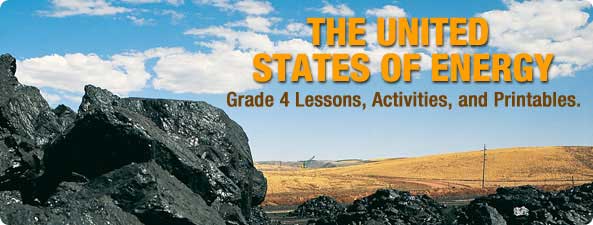Scholastic U-Turn On Coal: Shame About Their Other Partners
Posted by keith on May 17th, 2011
Well, that didn’t last long. From the first outrage to a “Move along, nothing to see here!” clean up of the website, Scholastic seem to have recovered relatively easily from what they claim was just a mistake. When Scholastic published a set of four worksheets and a printable map (see here for a cache image) that had been produced by the American Coal Institute, the group Campaign for a Commercial Free Childhood went into overdrive. May 11, 2011 saw the first offensive which had snowballed into a well-orchestrated furore the next day, followed a couple of days later by an apparently complete reversal of publishing policy by the much-loved American publisher of schoolbooks and materials.
Here’s how it played out in the New York Times:
Coal Curriculum Called Unfit for 4th Graders
Published: May 11, 2011
Three advocacy groups have started a letter-writing campaign asking Scholastic Inc. to stop distributing the fourth-grade curriculum materials that the American Coal Foundation paid the company to develop.
The three groups — Rethinking Schools, the Campaign for a Commercial-Free Childhood and Friends of the Earth — say that Scholastic’s “United States of Energy” package gives children a one-sided view of coal, failing to mention its negative effects on the environment and human health.
Kyle Good, Scholastic’s vice president for corporate communications, was traveling for much of Wednesday and said she could not comment until she had all the “United States of Energy” materials in hand.
Others at the company said Ms. Good was the only one who could discuss the matter. The company would not comment on how much it was paid for its partnership with the coal foundation.
Scholastic’s Big Coal Mistake
Published: May 12, 2011
Children’s books and other educational materials produced by the publisher Scholastic reach about 90 percent of the nation’s classrooms. With this enormous access to what amounts to a captive audience of children, the company has a special obligation to adhere to high educational standards.
It fell short of that when it produced a fourth-grade lesson packet called “The United States of Energy,” a treatise on coal that was paid for by the American Coal Foundation, a nonprofit group. As Tamar Lewin noted in The Times on Thursday, the lessons talked about the benefits of coal and the pervasiveness of power plants fueled by it — and omitted mention of minor things like toxic waste, mountain-top removal and greenhouse gases.
The issue came to light recently when children’s advocacy groups hammered Scholastic for giving a one-sided view of coal usage. This is not the first time that the company had come under fire. Last year, the Campaign for a Commercial-Free Childhood attacked Scholastic for encouraging schools to have classroom parties with, and to collect labels from, the sugary juice drink SunnyD as a way of winning free books.
(We’ll come to that last point later)
Letters: This Lesson Plan Is Brought to You by…
Published: May 16, 2011
“Scholastic’s Big Coal Mistake” (editorial, May 13) acknowledges that Scholastic’s children’s books, magazines, reading programs and Web site content are used in most American classrooms — a responsibility and trust that we have built through painstaking work through 90 years of service to teachers and schools.
A tiny percentage of this material is produced with sponsors, including government agencies, nonprofit associations and some corporations.
Your editorial criticizes a lesson packet called “The United States of Energy,” about different sources of energy — coal, nuclear, hydroelectric, solar, wind and natural gas — primarily for its sponsorship by the American Coal Foundation.
We acknowledge that the mere fact of sponsorship may call into question the authenticity of the information, and therefore conclude that we were not vigilant enough as to the effect of sponsorship in this instance. We have no plans to further distribute this particular program.
Because we have always been guided by our belief that we can do better, we are undertaking a thorough review of our policy and editorial procedures on sponsored content to ensure that we publish only those materials that are worthy of our reputation as “the most trusted name in learning.”
RICHARD ROBINSON
Chairman, President and C.E.O.
Scholastic Inc.
New York, May 13, 2011
It is now all but impossible to find any evidence that the worksheets and map were ever on the Scholastic web site unless you search various web caches. Of course the American Coal Foundation still proudly peddle their filth because that’s what business does. There is no sense in suggesting that the coal industry stop producing these materials as the commercial model that they and all corporations work by is the need to continually generate profit for shareholders; if they don’t grow then they fail, therefore any way of getting in the minds of vulnerable individuals (including you and me) is fair game for a corporation.
Scholastic is a corporation – it may produce what it likes to call “educational” materials (a.k.a. whatever is approved by the industrial capitalist system) but it still needs to make money, so willingly takes any handouts it can from other corporations. There isn’t a lot of money in “educational” publishing, the margins are simply too low, so sponsorship is the way to go for any good corporation. As CCFC point out:
For years, Scholastic has exploited its reputation as an educational publisher to serve as a Trojan horse for all sorts of inappropriate marketing in schools—from the highly commercialized content of its Book Clubs, to marketing the over-the-counter drug Claritin in elementary schools, to urging teachers to throw parties for the sugar-laden beverage SunnyD in their classrooms. Scholastic’s InSchool Marketing division offers its services as curriculum producer for hire. The program is designed “to promote client objectives” and “make a difference by influencing attitudes and behaviors.”
So this apparent U-turn and clean-up of the web site is really just a way of saving face because a lot of potential customers really do want less commercial influence in schools, enough customers to offset the losses caused by refunding the American Coal Foundation.
Not to worry, though, because there are plenty of other sponsorship opportunities available that might seem a little more acceptable to the school system. I had a look through the Science section on the Scholastic web site and, as they say, there are few overt commercial connections: I found the Lexus Environmental Challenge and the extremely blatant Count on Wet Ones Wipes (that’s for the indoctrination of tiny people). But what was more interesting was the number of resources that clearly had an extreme bias towards industry and the culture of imperialism:
What Is Technology, and How Does It Benefit Us? is such an obviously loaded title that you don’t have to read the contents to realise that technology is bound to be seen as a Great Thing. But read I did, and found this little gem (my emphasis):
Explain to students that although technology presents many benefits to humanity, there may also be by-products or issues that arise through the process of manufacturing and the development of technology. Engage students in a discussion of these benefits, as well as the by-products or issues and how these issues are being or might be addressed. If your students don’t include environmental challenges in their discussion, suggest the responsibility everyone has in controlling waste, and that recycling represents our effort to achieve that. Examples of how technology can enhance society might include: battery technology, solar power, satellites, text messaging, MP3s, gaming, plasma TVs, air and water testing, improved product designs.
Nice bit of accentuate the positive going on there.
The Culture of The Inca does a remarkable job in ignoring virtually anything to do with the culture of the Inca, including their brutal massacre by Spanish conquistadores, favouring instead to focus on llamas!
The empire of the Inca existed for many centuries in Peru. Today the descendants of these people continue many aspects of the culture, including traditional language, stories, folk songs, dance, and farming practices.
The descendants of the Inca still live in Peru. Visit them, listen to their songs, read their jokes, and try out a bit of their language at http://www.andes.org/.
[various instructions]
Did you notice llamas in the pictures you looked at? The llama was the most important animal to the Inca, and is still important today. To find out why, go to http://www.llamapaedia.com/origin/domestic.html. List at least three ways the Incas used llamas.
Extension Activity:
Llamas are also popular in the United States. You can find out much more about llamas at http://www.llamapaedia.com/index.html. Work with your classmates to research and report on different aspects of llama care, llama behavior, and how llamas are used today.
And just as I was going to wrap up the examples, I found a perfect example of state-sponsored brainwashing in the form of Save the Flag: Find out how to keep yours in shape for summer’s patriotic holidays. Are you ready?
What you need:
one 12″ x 12″ sample of each of the following: red felt, white felt, blue felt, 100% cotton white fabric
scissors
bowl of hot water
sandpaper
dirt
sunny window
What to do:
1. Discuss famous flags from U.S. history with your child — the Betsy Ross flag and the flag that inspired the national anthem, among others...
…at which point I could safely assume that Scholastic probably isn’t the best place to get information about the slaughter of Native American peoples either. Nope, thought not.






May 17th, 2011 at 10:17 am
Great exposé on the back door commercialisation of kids in the USA. They way the tories are outsourcing everything, I’m sure we can expect this in the UK before too long – you can imagine MacDonalds writing the section on animal welfare…
Do you have any links to good/reliable information on the Native American slaughter? George Monbiot wrote about it here: http://www.monbiot.com/2010/01/11/the-holocaust-we-will-not-see/
May 17th, 2011 at 11:29 am
Thanks Martin. There is a very interesting resource of official documents here: http://www2.csusm.edu/nadp/
It’s written as things happened, and unedited as far as I can see, so you get a very good idea of attitudes at the time. The total Native American population (from http://www2.csusm.edu/nadp/r872001d.htm) should be taken in the context of a former population of around 2 million.
May 17th, 2011 at 8:32 pm
There’s a nice rebuttal to Avatar here:
http://bat-bean-beam.blogspot.com/2010/01/postcolonialicious.html
and this too:
http://io9.com/5422666/when-will-white-people-stop-making-movies-like-avatar
If they’re gonna deal with colonialism, actually focus on the victims not one of the oppressors turned so called good guy.
May 18th, 2011 at 5:37 am
Great article, Keith.
Regarding the slaughter of indigenous peoples i’d add to Monbiot’s (traitor that he is) recommendation of American Holocaust by David Stannard, it’s a must read – there are some excerpts here: http://www.thirdworldtraveler.com/History/American_Holocaust.html
and a 102 minute video of Stannard talking about the book here: http://www.youtube.com/watch?v=Qra6pcn4AOE
I’d also suggest a great book by Sven Lindqvist called ‘Exterminate all the Brutes’ about European genocide in Africa. The history of civilisation’s murderous brutality against the indigenous is truly horrific, more people need to know this.
June 6th, 2011 at 6:03 am
“Of course the American Coal Foundation still proudly peddle their filth because that’s what business does.”
—
reminds me of the recent essay, Green capitalism: the god that failed, by Richard Smith:
Google quick view:
http://tinyurl.com/64sjqrx
PDF:
http://www.paecon.net/PAEReview/issue56/Smith56.pdf
i suspect Smith is too pro-civilization, Socialist though he appears to be, for the likes of this blog, but this essay is still an excellent, in my opinion, debunking of the idea that capitalism, “green” or not, and (so-called, nonexistent) “free markets” will magically save the day.